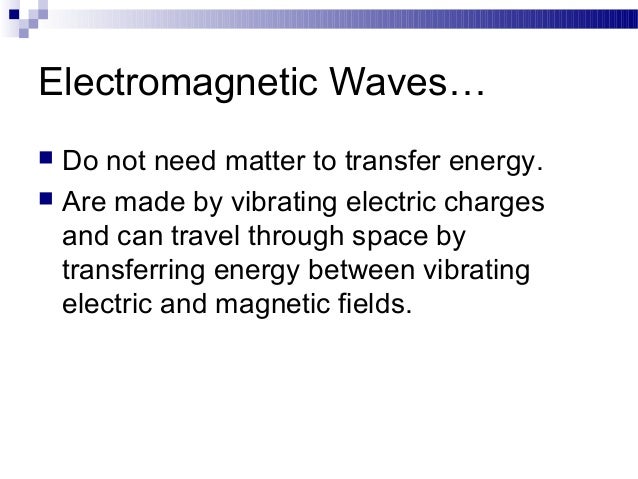12 July 2017 | Reading Time: 3minutes
Waves as energy transfer. ‘Wave’ is a common term for a number of different ways in which energy is transferred: In electromagnetic waves, energy is transferred through vibrations of electric and magnetic fields. In sound waves, energy is transferred through vibration of air particles or particles of a solid through which the sound travels. I transmit a light wave through the fiber; my light wave goes on-on-off-on-off-off-on-off-off-on-on-on, or so, by which I mean for you to read out a binary number like 1101 0010 0111. Seismic, sound, ocean, and light. Substance through which a wave can send a vibration. Medium (media) Give 3 examples of media. Solid, liquid, gas. Two types of waves. Electromagnetic and mechanical. What is a medium. Substance through which a wave can send a vibration or travel.

RF wireless infrastructure helps to shape the networks we know today; in fact,an integrated approach to wireless infrastructure can boost-end user adoption, leverage existing infrastructure and applications, enable enhanced working and reduced costs. Supported and complemented by cabling infrastructure, wireless is a core part of effective networks.
But how do wireless networks actually work? What infrastructure is required and what must we consider for successful performance?
What Do Waves Transfer From One Place To Another

How Are RF Signals Transmitted?
Just how is data sent and received across wireless networks?
Radio is the transmission of signals by the modulation of electromagnetic waves.
For example, if you were at a radio studio, sound or voice waves are picked up by a microphone that has electrical current running through it.
These sound waves create vibrations in the current as they travel through wires to a control room. In the control room technicians adjust the volume and they are transmitted out through an aerial or antenna. These signals go out through the air as radio waves. Radio waves are not directional and travel through space in all directions, like ripples on a pond. That is the transmitting of data on RF signals in a nutshell!
The Wireless Network Infrastructure Required to Transmit Data
The process of sending and receiving radio signals through wireless networks involves two devices, the transmitter and the receiver. The receiver picks up the waves with its antenna or aerial and turns the electric signal back into sound where it can be heard.
To transmit sound by radio, the transmitter adds a high frequency carrier wave to the sound signal. This makes the amplitude of the carrier wave change, but the frequency stays the same. This is called Amplitude Modulation. This form of modulation produces frequencies which are the ‘sum and the difference’ of the carrier and modulation frequencies. These frequencies are sometimes called sidebands.
What is QAM?

QAM (Quadrature Amplitude Modulation) is a modulation scheme that enables digital information to be transmitted between two points. Fundamentally, QAM enables an analog signal to efficiently transmit digital information. It also provides the means by which a wireless network operator transmits more bits in the same time period, which effectively increases the bandwidth.
What Do Waves Transmit To Earth
QAM is a modulation scheme that transmits data by changing the amplitude, or power level, of two signals: first in-phase with the incoming data and the second 90 degrees out of phase. QAM relates to the number of bits of information encoded in each time period.
For example, eight bits defines the number of combinations that are possible for those two signals (in phase and 90 degrees out of phase). If there are 256 combinations possible for those eight bits, then it is referred to as 256 QAM.
Understanding Modulation And Its Impact On Radio Communications
Radio Engineers will often talk about their modulation schemes, Mentioning 4QAM, 16QAM, 256QAM and so on. While higher order modulation rates are able to offer much faster data rates and higher levels of spectral efficiency for the radio communications system, this comes at a price.
The higher order modulation schemes are considerably less resilient to noise and interference. The key point here is that the higher the modulation signal, the more symbols are being transmitted and the closer together those symbols are.
As a result of this, many radio communications systems now use dynamic adaptive modulation techniques. They sense the channel conditions and adapt the modulation scheme to obtain the highest data rate for the given conditions.
Avoiding Errors in Data Transmission
As signal to noise ratios decrease, errors will increase along with re-sends of the data, thereby slowing throughput. By reverting to a lower order modulation scheme the link can be made more reliable with fewer data errors and re-sends.
This means for a RF signal, the more susceptible the antenna is to interference the more likely the performance will degrade.
Understand the Passive Infrastructure That Underpins Your Network
Of course, RF Infrastructure is just one of multiple aspects of passive infrastructure.
Facilitating ever growing and expanding networks, passive infrastructure is set to increase as demand for global telecommunications infrastructure advances. To stay ahead of demand, you can read more in oureBook: Understand the Passive Infrastructure that Underpins Your Network.
PreviousNext
